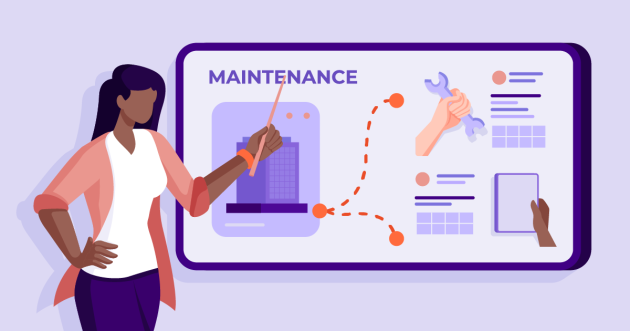How the Right Asset Management Software Can Transform Your HVAC Business

Managing a Heating, Ventilation, and Air Conditioning (HVAC) business involves juggling numerous tasks, from customer service to ensuring that equipment functions optimally. One of the most challenging aspects is maintaining a vast array of assets efficiently. HVAC businesses often struggle with this, leading to operational inefficiencies and increased costs.
In this blog post, we’ll explore the common challenges HVAC businesses face in asset maintenance and how asset management software like FieldInsight can provide the right solution.
Challenges in HVAC Asset Maintenance
Diverse Asset Range
HVAC businesses manage a wide variety of physical assets, including air conditioners, heaters, and ventilation systems. Each type of equipment has unique maintenance needs, and keeping track of all these requirements can be overwhelming.
Different equipment types have different operational characteristics, maintenance schedules, and wear-and-tear patterns. Without a comprehensive asset maintenance management system, it becomes difficult to ensure that each piece of equipment receives the specific care it needs to function efficiently and reliably.
Missed Maintenance Schedules
Scheduled maintenance is crucial for the longevity and efficiency of HVAC systems. Without a robust asset maintenance management software in place, it’s easy for maintenance schedules to fall through the cracks. Missed maintenance can lead to equipment failures and costly repairs, disrupting service delivery.
This oversight often results in minor issues escalating into major problems, requiring more extensive and expensive interventions. Furthermore, missed maintenance can lead to the premature aging of physical assets, reducing their overall lifespan and increasing the frequency of replacements.
Unexpected Equipment Failures
Unplanned equipment breakdowns are a significant issue in the HVAC industry. These failures often result from inadequate maintenance and can cause service delays, impacting customer satisfaction. When maintenance is not performed regularly, worn parts are not replaced, and minor issues are not addressed promptly, leading to unexpected asset failures. These emergency repairs not only disrupt service schedules but also strain the service team’s resources. The unpredictability of these failures can cause a ripple effect, delaying other scheduled maintenance and repairs, ultimately compromising the business’s ability to deliver timely and reliable service.
Service Delays
When equipment fails unexpectedly, service teams are forced into reactive maintenance, which can lead to significant delays. This not only frustrates customers but also strains the service team’s resources. Reactive maintenance is often more time-consuming and costly than proactive scheduled maintenance because it involves diagnosing the problem, sourcing parts, and making repairs under time constraints. The disruption caused by emergency repairs can also lead to missed appointments and extended downtime for other assets, further compounding the issue. Frequent service delays can damage the reputation of the HVAC business, leading to loss of clients and decreased customer retention.
The Impact of Ineffective Asset Maintenance
Increased Operational Costs
Inadequate maintenance leads to frequent equipment failures, necessitating expensive repairs or replacements. These costs add up, straining the business’s finances. Without effective maintenance management, HVAC businesses face increased repair costs due to unplanned breakdowns and emergency repairs. Over time, these costs can become unsustainable, eroding profit margins. Additionally, the lack of a systematic approach to maintenance and asset management can result in higher energy consumption, as poorly maintained equipment tends to operate less efficiently. This further exacerbates operational costs, making it difficult for HVAC businesses to remain competitive in the market.
Compromised Service Quality
HVAC companies rely on their reputation for providing reliable service. Ineffective asset maintenance can lead to unreliable service delivery, affecting client satisfaction and retention. When maintenance is neglected, the integrity and reliability of HVAC assets are compromised, leading to frequent service interruptions and subpar performance. This not only frustrates customers but also undermines their trust in the company’s ability to meet their needs. Over time, compromised service quality can tarnish the company’s reputation, making it harder to attract new clients and retain existing ones. In contrast, robust asset maintenance software, such as FieldInsight, can help ensure that all equipment operates at peak efficiency, enhancing overall service quality.
Customer Retention Issues
When clients experience frequent service disruptions, they are less likely to continue doing business with the HVAC company. This can lead to a loss of long-term customers and a damaged reputation. Customer retention is crucial for the sustained growth of HVAC businesses, and ineffective asset maintenance can severely impact it. Frequent asset failures and service delays not only inconvenience clients but also lead to dissatisfaction and frustration. Customers who experience unreliable service are more likely to seek alternatives, resulting in lost revenue and a negative impact on the business’s reputation. Implementing a robust maintenance and asset management system can help prevent these issues, ensuring consistent service delivery and higher customer satisfaction.
Accelerated Wear and Tear
Without regular maintenance, HVAC equipment wears out faster. This not only shortens the lifespan of the assets but also increases the frequency of replacements, adding to the overall costs. Regular maintenance is essential for extending asset life and ensuring asset reliability. When maintenance schedules are neglected, components wear out prematurely, leading to increased downtime and repair costs. Over time, the cumulative effect of accelerated wear and tear can significantly impact the business’s bottom line. Maintenance software can help monitor the condition of equipment, schedule timely maintenance, and track the performance of each asset, ensuring that they remain in optimal working condition for longer periods.
Decreased Asset Reliability
Asset reliability is critical for HVAC businesses, as it directly impacts service delivery and customer satisfaction. Ineffective maintenance practices lead to frequent breakdowns, reducing the overall reliability of HVAC systems. This not only disrupts service schedules but also increases the workload on the maintenance team, leading to potential burnout and further inefficiencies. By implementing a comprehensive asset maintenance management system, businesses can enhance the reliability of their equipment, ensuring that it operates consistently and efficiently.
Increased Repair Costs
Ineffective maintenance often results in minor issues being overlooked until they escalate into major problems. This leads to increased repair costs, as more extensive and costly interventions are required to fix the issues. Additionally, emergency repairs are typically more expensive than scheduled maintenance due to the urgency and complexity involved. By utilizing asset maintenance software, HVAC businesses can identify and address potential problems early, reducing the likelihood of costly emergency repairs and keeping repair costs under control.
Loss of Competitive Edge
In the competitive HVAC industry, businesses that fail to maintain their assets effectively risk losing their competitive edge. Ineffective maintenance practices can lead to decreased operational efficiency, higher costs, and reduced service quality, making it difficult for businesses to compete with those that have optimized their maintenance processes. By adopting advanced maintenance and asset management solutions, like FieldInsight, HVAC companies can streamline their operations, reduce costs, and enhance service quality, thereby maintaining their competitive edge in the market.
Leveraging Asset Management Software like FieldInsight
Automated Scheduling
Asset management software like FieldInsight automates the scheduling of inspections and maintenance, ensuring that no equipment is overlooked. This reduces the risk of missed maintenance and helps keep everything running smoothly. Automated scheduling eliminates the need for manual tracking, which is often prone to errors and omissions. By setting up predefined maintenance schedules, the software ensures that each piece of equipment receives timely attention. This systematic approach not only enhances the efficiency of your operations but also helps extend asset life by preventing the deterioration that occurs due to neglect.
Routine Servicing
FieldInsight’s asset maintenance management system keeps detailed records of each asset’s performance and service history, making it easier to ensure that all equipment is routinely serviced according to its specific needs. Regular servicing is crucial for maintaining asset integrity and performance. The software provides a comprehensive overview of the maintenance history, enabling technicians to follow precise servicing protocols tailored to each asset. This meticulous attention to detail helps in maintaining optimal operating conditions and prolongs the lifespan of the equipment, ultimately leading to reduced maintenance costs and improved reliability.
Predictive Maintenance
Advanced asset management software like FieldInsight uses real-time data analytics to predict when maintenance is needed, preventing equipment failures before they occur. This proactive approach minimizes downtime and enhances efficiency. Predictive maintenance leverages sensors and IoT technology to monitor the condition of assets continuously. By analyzing data trends, the software can forecast potential issues and trigger maintenance actions before failures happen. This not only improves asset integrity but also optimizes operations by focusing resources on the most critical areas, thereby avoiding unnecessary maintenance and reducing operational disruptions.
Detailed Performance Records
Having detailed records of each asset’s performance helps in identifying patterns and potential issues before they escalate. This data-driven approach allows for better decision-making and resource allocation. FieldInsight’s asset maintenance management system provides in-depth insights into the operational status of all assets. By maintaining comprehensive logs of performance metrics, maintenance activities, and any anomalies, the software enables managers to spot recurring issues and address them proactively. This enhances asset reliability and supports strategic planning, ensuring that maintenance efforts are aligned with the overall business goals.
Enhanced Compliance and Reporting
FieldInsight’s asset maintenance system ensures that all activities are documented in detail, facilitating compliance with industry regulations and standards. Accurate record-keeping simplifies audit processes and demonstrates adherence to best practices. This not only protects the business from legal liabilities but also builds trust with clients by showcasing a commitment to quality and safety.
Improved Resource Utilization
Efficient operations are crucial for optimizing resource allocation. FieldInsight helps in prioritizing maintenance tasks based on urgency and impact, ensuring that the most critical issues are addressed promptly. This strategic allocation of resources minimizes downtime and maximizes the productive use of personnel and materials, leading to cost savings and enhanced operational efficiency.
Scalability and Flexibility
As HVAC businesses grow, their asset maintenance needs become more complex. FieldInsight’s asset maintenance system is designed to scale with the business, accommodating an increasing number of assets and maintenance jobs. The software’s flexibility allows it to be customized to meet specific business requirements, making it a valuable tool for both small and large HVAC companies.
Enhanced Communication and Coordination
Effective communication and coordination are essential for smooth maintenance operations. FieldInsight facilitates seamless communication between maintenance teams, ensuring that everyone is on the same page. The software’s real-time updates and notifications keep all stakeholders informed about the status of maintenance activities, preventing misunderstandings and ensuring timely interventions.
Benefits of Asset Management Software
- Streamlined Operations: Automating and streamlining maintenance processes reduces the administrative burden on HVAC businesses, allowing them to focus on core activities. This saves time and increases overall operational efficiency, enabling companies to allocate their resources more effectively and concentrate on growth and customer service strategies.
- Reduced Downtime: Proactive maintenance and predictive analytics minimize equipment downtime, ensuring that HVAC systems are always operational when needed. This approach helps manage assets more effectively by addressing potential issues before they lead to significant disruptions, ensuring continuous and reliable service delivery.
- Extended Equipment Lifespan: Regular maintenance extends the lifespan of HVAC equipment, reducing the need for frequent replacements and lowering overall costs. By systematically maintaining and servicing equipment, businesses can ensure asset integrity and reliability, leading to long-term cost savings and enhanced operational performance.
- Enhanced Reliability: With all assets performing optimally, HVAC businesses can provide more reliable service to their clients, boosting customer satisfaction and retention. Reliable service strengthens customer trust and loyalty, contributing to a positive reputation and ongoing support from satisfied clients.
- Data-Driven Insights: The software provides valuable insights into asset performance and maintenance needs, enabling HVAC businesses to make informed decisions and optimize their operations. Utilizing historical data and real-time analytics, companies can develop future strategies that enhance efficiency and productivity.
- Cost Savings: By preventing unexpected breakdowns and extending the lifespan of equipment, asset management software helps HVAC businesses save money in the long run. The ability to predict and address potential issues before they escalate into costly repairs results in significant financial benefits.
- Improved Compliance: Maintaining compliance with industry regulations is crucial for HVAC businesses. Asset management software ensures that all maintenance activities are documented and compliant with standards. This meticulous record-keeping not only protects the business from legal liabilities but also enhances its credibility and trustworthiness.
- Increased Productivity: With automated processes and reduced downtime, the service team can focus on more critical tasks, improving overall productivity. This efficiency allows businesses to take on more projects and deliver services faster, enhancing their competitive edge in the market.
- Enhanced Customer Experience: Timely and reliable service enhances the customer experience, leading to higher satisfaction rates and positive reviews. A satisfied customer base is more likely to provide ongoing support and referrals, driving business growth and success.
- Scalability: As the HVAC business grows, asset management software can scale to accommodate the increasing number of assets, ensuring that maintenance processes remain efficient. This scalability ensures that businesses can manage assets effectively regardless of their size, adapting to future needs without compromising on service quality.
Key Features of Asset Management Software
Real-Time Monitoring
Real-time monitoring of equipment allows for immediate detection of issues, enabling quick resolution and minimizing downtime. This feature is crucial for maintaining the operational integrity of HVAC systems. By continuously tracking the performance of assets, the software can alert maintenance teams to anomalies or potential failures before they become critical. This proactive approach ensures that minor issues are addressed promptly, preventing them from escalating into major problems that can disrupt service delivery and lead to costly repairs.
Mobile Access
Mobile access to the software ensures that maintenance teams can update and access information from the field, improving responsiveness and efficiency. Technicians can log maintenance activities, check schedules, and receive alerts directly on their mobile devices, eliminating the need for paper records and reducing the risk of errors. This capability enhances the agility of the maintenance operations, allowing for faster response times and more efficient coordination among team members. Mobile access also ensures that all data is updated in real-time, providing an accurate and current view of the asset’s status and maintenance history.
Integration Capabilities
Integration with other business systems, such as customer relationship management (CRM) and enterprise resource planning (ERP), provides a holistic view of operations and enhances coordination. This seamless integration allows for the sharing of data across different platforms, ensuring that all departments have access to the same information. For example, integrating asset management software with a CRM system can provide customer service teams with insights into the maintenance status of customer equipment, enabling them to offer more informed support. Similarly, integration with ERP systems can help in planning and budgeting for maintenance activities, aligning them with overall business objectives.
Customizable Dashboards
Customizable dashboards provide an at-a-glance overview of asset status, maintenance schedules, and performance metrics, helping managers make informed decisions. These dashboards can be tailored to display the most relevant information for different users, whether they are technicians, managers, or executives. By presenting key data in a visually accessible format, customizable dashboards facilitate quick assessment of asset health and performance. This enables managers to prioritize maintenance tasks, allocate resources more effectively, and identify areas that require attention. The ability to customize dashboards ensures that each user has access to the information they need to perform their role efficiently.
Reporting and Analytics
Advanced reporting and analytics capabilities allow HVAC businesses to track performance, identify trends, and make data-driven improvements to their maintenance processes. The software can generate detailed reports on various aspects of asset management, including maintenance activities, downtime, repair costs, and asset utilization. These reports provide valuable insights that can help in optimizing maintenance strategies, improving asset reliability, and reducing operational costs. Analytics tools can also identify patterns and trends in the data, such as recurring issues with specific types of equipment or the impact of certain maintenance activities on asset performance. By leveraging these insights, businesses can continuously refine their maintenance practices and
achieve better outcomes.
Predictive Maintenance
Predictive maintenance capabilities use real-time data and advanced algorithms to forecast when maintenance should be performed. This feature helps in preventing unexpected failures and extending the lifespan of assets. By analyzing data from sensors and other monitoring tools, the software can predict potential problems before they occur, allowing for timely interventions that minimize disruption and costs.
Inventory Management
An integrated inventory management system ensures that the necessary spare parts and materials are always available for maintenance tasks. This feature helps in tracking stock levels, managing orders, and reducing the risk of downtime due to unavailable parts. Efficient inventory management supports smoother maintenance operations and reduces delays.
Work Order Management
Work order management capabilities streamline the process of scheduling, assigning, and tracking maintenance tasks. The software can automatically generate work orders based on predefined criteria, assign them to the appropriate technicians, and track their progress until completion. This ensures that maintenance activities are carried out efficiently and on time.
Compliance Management
Compliance management features help HVAC businesses adhere to industry regulations and standards. The software can ensure that all maintenance activities are documented and compliant with relevant guidelines, reducing the risk of legal issues and enhancing the company’s reputation for reliability and quality.
In the competitive HVAC industry, efficient asset maintenance is crucial for success and customer satisfaction. HVAC businesses often struggle with maintaining diverse equipment, leading to increased costs and compromised service quality. However, the right asset management software such as FieldInsight can transform maintenance processes by automating scheduling, enabling predictive maintenance, and providing data-driven insights. This reduces downtime, extends equipment lifespan, and enhances reliability.
Investing in robust asset management software improves operational efficiency and customer satisfaction, ensuring long-term success. If your HVAC business is struggling with asset maintenance, now is the time to evaluate your current processes, identify areas for improvement, and explore the available software options. Implementing the right solution will streamline operations, ensure reliable service, and secure a competitive edge.
What You Should Do Now
- Book a Demo. You’ll be in touch with an automation expert who has worked in this space for over 5 years, and knows the optimal workflow to address your needs.
- If you’d like access to free articles about managing HVAC workflows, go to our blog.
- If you know someone who’d enjoy reading this page, share it with them via email, Linkedin, Twitter, or Facebook.










